 W
WThe history of printing starts as early as 3500 BCE, when the proto-Elamite and Sumerian civilizations used cylinder seals to certify documents written in clay. Other early forms include block seals, hammered coinage, pottery imprints, and cloth printing. Initially a method of printing patterns on cloth such as silk, woodblock printing originated in China around 200 AD, and was transferred to paper by the 7th century, leading to the spread of book production in Asia. Movable type was invented in the Song dynasty in the eleventh century but it received limited use compared to woodblock printing. Woodblock printing was also used in Europe until the fifteenth century when a process for mass-producing metal type and the printing press were invented to support an economical book publishing industry. This industry enabled the communication of ideas and sharing of knowledge on an unprecedented scale. Alongside the development of text printing, new and lower-cost methods of image reproduction were developed, including lithography, screen printing and photocopying.
 W
WPrinting is a process for mass reproducing text and images using a master form or template. The earliest non-paper products involving printing include cylinder seals and objects such as the Cyrus Cylinder and the Cylinders of Nabonidus. The earliest known form of printing as applied to paper was woodblock printing, which appeared in China before 220 AD for cloth printing. However, it would not be applied to paper until the seventh century. Later developments in printing technology include the movable type invented by Bi Sheng around 1040 AD and the printing press invented by Johannes Gutenberg in the 15th century. The technology of printing played a key role in the development of the Renaissance and the Scientific Revolution and laid the material basis for the modern knowledge-based economy and the spread of learning to the masses.
 W
WThe 31-line Indulgence is a plenary indulgence granted by Pope Nicholas V and issued in Erfurt on 22 October 1454. It is the earliest known document with a fixed date printed by movable type, which had recently been invented by Johannes Gutenberg. One of 46 surviving copies is preserved in the Scheide Library at Princeton.
 W
WThe A.L. Monsohn Lithographic Press was established in Jerusalem in 1892 by Abraham-Leib Monsohn II and his brother Moshe-Mordechai (Meyshe-Mordkhe). Sponsored by members of the Hamburger family, the brothers had been sent to Frankfurt in 1890 to study lithography. Upon returning to Jerusalem with a hand press, they established the A.L. Monsohn Lithographic Press in the Old City of Jerusalem.
 W
WThe altarpiece of Pellegrino II is a medieval altarpiece in the cathedral of Cividale, Italy. The silver relief was endowed by Pellegrino II, the patriarch of Aquileia, around 1200 and adorns today the main altar of the church Santa Maria Assunta. It shows Mary and the Child Jesus surrounded by archangels and groups of saints. The piece is notable for its rich ornamentation and its early typographic inscription.
 W
WAfter the introduction of movable printing type to Europe by Johannes Gutenberg in Germany, Armenians from throughout the diaspora began to publish Armenian-language books. The first book which had Armenian letters was published in Mainz (Germany) in 1486. The first Armenian book to be published by the printing press was Urbatagirq—Book of Friday prayers—which was published by Hakob Meghapart in Venice in 1512.
 W
WArt Nouveau posters and graphic arts flourished and became an important vehicle of the style, thanks to the new technologies of color lithography and color printing, which allowed the creation of and distribution of the style to a vast audience in Europe, the United States and beyond. Art was no longer confined to art galleries, but could be seen on walls and illustrated magazines.
 W
WBanging out is a tradition in some British industries to mark the completion of an apprenticeship or a retirement of an employee. Particularly associated with the printing rooms of national newspapers in Fleet Street the "banging" is the noise made by colleagues hitting metal furniture or machinery and accompanies the former apprentice or retiree walking across the shop floor. The tradition developed further when apprentices would be placed in a truck and showered in printers' ink, glue and paper, a tradition that continues in some companies. Despite the outsourcing of printing from newspaper offices the tradition for retirees continues in modern newsrooms, with the banging being provided by colleagues hitting their desks.
 W
WThe Belgrade printing house was a printing house established by count Radiša Dmitrović in Belgrade, Ottoman Serbia. It was the first printing house in Belgrade. After Dmitrović's death, the printing house was taken over by Trojan Gundulić, who organized publishing of the first and only book of this printing house, the Gospel, printed and edited in 1552 by Hieromonk Mardarije.
 W
WThe Simple Words of Catechism by Martynas Mažvydas is the first printed book in the Lithuanian language. It was printed on 8 January 1547 by Hans Weinreich in Königsberg. The 79-page book followed the teachings of Martin Luther but reflects both religious and secular needs. The book included the first Lithuanian-language poem, primer with alphabet, basic catechism, and 11 religious hymns with sheet music. The book was written in the Samogitian dialect and printed in Gothic (schwabacher) font; Latin dedication and preface are printed in Latin font (antiqua).
 W
WChromoxylography was a colour woodblock printing process, popular from the mid-19th to the early-20th century, commonly used to produce illustrations in children's books, serial pulp magazines, and cover art for yellow-back and penny dreadfuls. The art of relief engraving and chromoxylography was perfected by engravers and printers in the 19th century, most notably in Victorian London by engraver and printer Edmund Evans who was particularly good with the process, producing a wide range of hues and tones through color mixing. Chromoxylography was a complicated technique, requiring intricate engraving and printing for the best results. Less expensive products, such as covers for pulp magazines, had to be produced with few colours, often only two or three, whereas more intricate and expensive books and reproductions of paintings used as many as a dozen or more colors. For each colour used, a separate woodblock had to be carved of the image being reproduced.
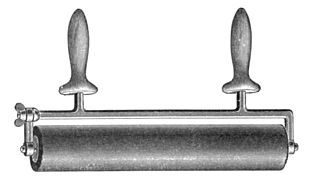 W
WA composition roller is a tool used in letterpress printing to apply ink to a bed of type in a printing press. It consists of a cylinder made of a substance known as "roller composition" or simply "composition", a mixture of glue and sugar, with various additives such as glycerin depending on the particular recipe. Early recipes also included gypsum plaster and tar, though these were eventually found unnecessary.
 W
WThe Crnojević printing house or Cetinje printing house, was the first printing house in Southeastern Europe; the facility operated between 1493 and 1496 in Cetinje, Zeta.
 W
WFluorine etching is a printmaking technique developed by a circle of artists working in Cracow and Warsaw in the first two decades of the twentieth century. It is likely that both the detrimental effects on the health of engravers and the fragility of the material resulted in this technique being abandoned.
 W
WThe global spread of the printing press began with the invention of the printing press with movable type by Johannes Gutenberg in Mainz, Germany c. 1439. Western printing technology was adopted in all world regions by the end of the 19th century, displacing the manuscript and block printing.
 W
WThe Goražde printing house was one of the earliest printing houses among the Serbs, and the first in the territory of present-day Bosnia and Herzegovina. Established in 1519 in Venice, it was soon relocated to the Serbian Orthodox Church of Saint George in the village of Sopotnica near Goražde, in the Ottoman Sanjak of Herzegovina. It was founded and run by Božidar Ljubavić, also known as Božidar Goraždanin, who was a prominent merchant from Goražde. His son Teodor Ljubavić, a hieromonk of the Mileševa Monastery, managed the work of the printing house. It worked until 1523, producing three books, which are counted among the better accomplishments of early Serb printers.
 W
WThe Gutenberg Museum is one of the oldest museums of printing in the world, located opposite the cathedral in the old part of Mainz, Germany. It is named after Johannes Gutenberg, the inventor of printing from movable metal type in Western Europe. The collections include printing equipment and examples of printed materials from many cultures.
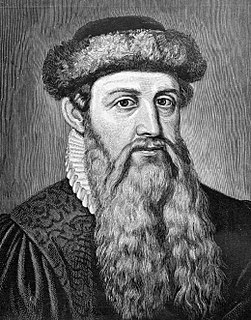 W
WJohannes Gensfleisch zur Laden zum Gutenberg was a German goldsmith, inventor, printer, and publisher who introduced printing to Europe with his mechanical movable-type printing press. His work started the Printing Revolution and is regarded as a milestone of the second millennium, ushering in the modern period of human history. It played a key role in the development of the Renaissance, Reformation, Age of Enlightenment, and Scientific Revolution, as well as laying the material basis for the modern knowledge-based economy and the spread of learning to the masses.
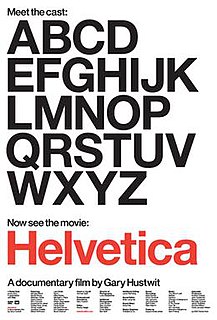 W
WHelvetica is a 2007 American independent feature-length documentary film about typography and graphic design, centered on the eponymous typeface. Directed by Gary Hustwit, it was released in 2007 to coincide with the 50th anniversary of the typeface's introduction in 1957 and is considered the first of the Design Trilogy by the director.
 W
WHu Zhengyan was a Chinese artist, printmaker and publisher. He worked in calligraphy, traditional Chinese painting, and seal-carving, but was primarily a publisher, producing academic texts as well as records of his own work.
 W
WJugendstil was an artistic movement, particularly in the decorative arts, that was influential primarily in Germany and elsewhere in Europe to a lesser extent from about 1895 until about 1910. It was the German counterpart of Art Nouveau. The members of the movement were reacting against the historicism and neo-classicism of the official art and architecture academies. It took its name from the art journal Jugend, founded by the German artist Georg Hirth. It was especially active in the graphic arts and interior decoration.
 W
WLetterpress printing is a technique of relief printing. Using a printing press, the process allows many copies to be produced by repeated direct impression of an inked, raised surface against sheets or a continuous roll of paper. A worker composes and locks movable type into the "bed" or "chase" of a press, inks it, and presses paper against it to transfer the ink from the type, which creates an impression on the paper.
 W
WThe Medici Oriental Press was a press established by Ferdinand de Medici in the 16th century. This press produced some of the earliest books printed in Arabic. The press was active from 1584 to 1614.
 W
WMedieval letter tiles are one-letter ceramic tiles that were employed in monasteries and churches of the late Middle Ages for the creation of Christian inscriptions on floors and walls. They were created by pressing stamps bearing a reverse image into soft clay, which was then baked hard, and they were used to form words by assembling single-letter tiles in the desired order.
 W
WThe Mileševa printing house was a printing house established in 1544 in the Mileševa monastery near Prijepolje, Ottoman Empire. Three srbulje books were printed in this printing house. Two in 1544 and 1545 and one in 1557.
 W
WMovable type is the system and technology of printing and typography that uses movable components to reproduce the elements of a document usually on the medium of paper.
 W
WThe Mrkšina crkva printing house was a printing house established in 1562 in the Monastery of Mrkšina Crkva in village Kosjerić in Ottoman Serbia. This printing house was operational until 1566 and printed two srbulje books, The Four Gospels (Четворојеванђеље) in 1562 and The Flower Triod in 1566. In 1567 the Ottomans destroyed the church and its printing house.
 W
WThe Musée de l'Imprimerie is a museum in Lyon, France, with the mission of enhancing, conserving, documenting and valuing the heritage of printed books and graphic arts.
 W
WThe New South Wales General Standing Orders was the first compilation of government orders and notices intended to inform colonists of the law as it stood in 1802 after the arrival of the First Fleet. It was the first book to be printed in Australia.
 W
WThis list of the oldest newspapers sorts the newspapers of the world by the date of their first publication. The earliest newspapers date to 17th century Europe when printed periodicals began rapidly to replace the practice of hand-writing newssheets. The emergence of the new media branch has to be seen in close connection with the simultaneous spread of the printing press from which the publishing press derives its name. The oldest living newspaper in the world, and with the same title, is the Gazzetta di Mantova, regularly published in Mantua (Italy) since 1664.
 W
WA paper-ruling machine is a device for ruling paper. In 1770, John Tetlow was awarded a patent for a "machine for ruling paper for music and other purposes." William Orville Hickok invented an "improved ruling machine" in the mid-19th century. As the device is designed for drawing lines on paper, it can produce tables and ruled paper.
 W
WGiovanni Battista Pasquali was a leading printer in 18th-century Venice, supported by the British consul Joseph Smith (1682–1770), a patron and collector. Pasquali was a scholar himself, who published his own essays as well as finely printed, unpretentious editions for a scholarly readership. He signed the Latin preface to his printed catalogue of Smith's distinguished library, Bibliotheca Smithiana, seu Catalogus librorum d. Josephi Smithii. Pasquali's peers in the revival of fine printing among the presses of Venice were the editor and connoisseur Giovanni Battista Albrizzi and the political writer and publisher Antonio Zatta.
 W
WGeorges Louis Jean Baptiste Peignot was a French type designer, type founder, and manager of the G. Peignot & Fils foundry until his death in the World War I. Father of four children, he hoisted the G. Peignot & Fils foundry among the most striking French typography companies of the twentieth century : in 17 years of practice, he created or launched prestigious fonts, including Grasset, Cochin, and Garamont.
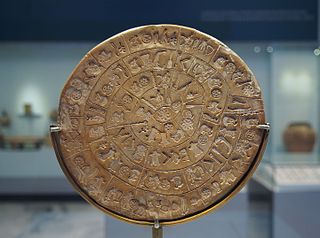 W
WThe Phaistos Disc is a disk of fired clay from the Minoan palace of Phaistos on the island of Crete, possibly dating to the middle or late Minoan Bronze Age. The disk is about 15 cm (5.9 in) in diameter and covered on both sides with a spiral of stamped symbols. Its purpose and its original place of manufacture remain disputed. It is now on display at the archaeological museum of Heraklion.
 W
WIn the 1860s the first facsimile of Domesday Book was created by the process of photozincography, and was executed under the directorship of Henry James at the Southampton offices of the Ordnance Survey.
 W
WThe history of printing in Poland began in the late 15th century, when following the creation of the Gutenberg Bible in 1455, printers from Western Europe spread the new craft abroad.
 W
WThe introduction and early development of printing in South India is attributed to missionary propaganda and the endeavours of the British East India Company. Among the pioneers in this arena, maximum attention is claimed by the Jesuit missionaries, followed by the Protestant Fathers and Hindu Pandits. Once the immigrants realized the importance of the local language, they began to disseminate their religious teachings through that medium, in effect ushering in the vernacular print culture in India. The first Tamil booklet was printed in 1554 in Lisbon - Cartilha em lingoa Tamul e Portugues in Romanized Tamil script by Vincente de Nazareth, Jorge Carvalho and Thoma da Cruz, all from the Paravar community of Tuticorin. it is also the first non-European language to find space in the modern printing culture in the world.
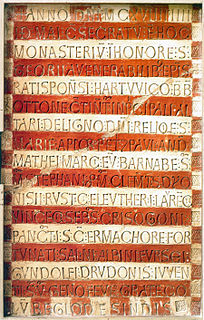 W
WThe Prüfening dedicatory inscription is a high medieval inscription impressed on clay which was created in 1119, over three hundred years before Johannes Gutenberg, by the typographic principle. The inscription plate belongs to the Prüfening Abbey, a former Benedictine monastery, in Regensburg, Germany.
 W
WRecuyell of the Historyes of Troye or Recueil des Histoires de Troye (1464) is a translation by William Caxton of a French courtly romance written by Raoul Lefèvre, chaplain to Philip III, Duke of Burgundy. It was the first book printed in the English language.
 W
WA reverse-contrast letterform is a typeface or custom lettering in which the stress is reversed from the norm: instead of the vertical lines being the same width or thicker than horizontals, which is normal in Latin-alphabet writing and especially printing, the horizontal lines are the thickest. The result is a dramatic effect, in which the letters seem to have been printed the wrong way round. Originally invented in the early nineteenth century as attention-grabbing novelty display designs, modern font designer Peter Biľak, who has created a design in the genre, has described them as "a dirty trick to create freakish letterforms that stood out."
 W
WJohann Christian Ritter was a German in the service of the Dutch East India Company who came to South Africa in 1784. He was the first to print in the Cape, the earliest record is an almanac titled "Almanach voor't jaar 1796".
 W
WA Roman lead pipe inscription is a Latin inscription on a Roman water pipe made of lead which provides brief information on its manufacturer and owner, often the reigning emperor himself as the supreme authority. The identification marks were created by full text stamps.
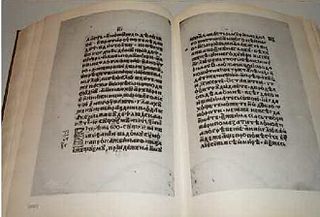 W
WThe Rujno Monastery printing house was a printing house established in 1537 in the Monastery of Saint George in village Vrutci of Rujno Župa near Užice, Ottoman Empire. The monastery had substantial income from its nearby spa so it established the printing house. Still, this income was insufficient for metal types. That is why hieromonk Teodosije, hegumen of the monastery, and his fellow monks, made types of 250 engraved wooden plates. They printed one book in this printing house, The Rujan Four Gospels. The Ottomans burned monastery together with its printing house to prevent further printing of books. Since 1984 the remnants of this monastery are below Lake Vrutci.
 W
WSerbian printing refers to the history of printing among Serbs, and focusing on development of book printing in Serbian language, by the use of Serbian Cyrillic alphabet, from the end of the 15th century, up to the end of the 18th century. The first state printing house, the Serbian Printing House, was established in 1832.
 W
WSt. Paul's Churchyard is an area immediately around St Paul's Cathedral in the City of London. It included St Paul's Cross and Paternoster Row. It became one of the principal marketplaces in London. It also contained St Paul's Cross, an open-air pulpit from which many of the most important statements on the political and religious changes brought by the Reformation were made public during the sixteenth and seventeenth centuries. Only one execution is recorded as taking place in St. Paul's Churchyard: that of Henry Garnet, one of those found guilty of the Gunpowder plot.
 W
WIn post-classical Arabic, a ṭarsh is an engraved block used for printing. They were made of wood or tin and were in use from the ninth or tenth century until at least the fourteenth. There are over a hundred known Arabic blockprints on paper, parchment and possibly papyrus. They are mostly small strips intended for use in amulets. They have mainly been identified in public and private collections, but a few prints have been recovered archaeologically at Fusṭāṭ in Egypt. No ṭarsh itself has yet been found.
 W
WTeaching to See is a 2012 educational documentary film about graphic design and teaching of Inge Druckrey and some of her students and colleagues. Directed by Andrei Severny and produced by Edward Tufte, it was released in July 2012 and was screened in New York, Boston, Phoenix, Toronto, Reykjavík, Philadelphia, Stanford, and New Haven.
 W
WThai typography concerns the representation of the Thai script in print and on displays, and dates to the earliest printed Thai text in 1819. The printing press was introduced by Western missionaries during the mid-nineteenth century, and the printed word became an increasingly popular medium, spreading modern knowledge and aiding reform as the country modernized. The printing of textbooks for a new education system and newspapers and magazines for a burgeoning press in the early twentieth century spurred innovation in typography and type design, and various styles of Thai typefaces were developed through the ages as metal type gave way to newer technologies. Modern media is now served by digital typography, and despite early obstacles including lack of copyright protection, the market now sees contributions by several type designers and digital type foundries.
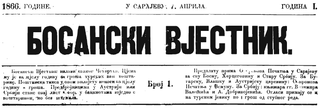 W
WThe Vilayet Printing House, originally named Sopron's Printing House, was the official printing house of the Ottoman Vilayet of Bosnia from April 1866 until the occupation of the province by Austria-Hungary in August 1878. It was the second printing house that operated in the territory of present-day Bosnia and Herzegovina, founded in Sarajevo almost 350 years after the Goražde printing house ceased its activity. Its founder was Ignjat Sopron, a publisher and printer from Zemun, who sold the establishment to the Government of the Vilayet of Bosnia in October 1866. Its foundation happened in the context of modernising and Europeanising Tanzimat reforms in the Ottoman Empire. Its principal aim was to issue an official gazette of the vilayet and publish textbooks for the elementary schools of Bosnian Serbs and Croats, thus stopping their import from the Principality of Serbia and the Austrian Empire.
 W
WThe Vuković printing house was 16th century printing house established in Venice by Božidar Vuković.
 W
WHans Weinreich was a publisher and printer of German and Polish language books in the first half of the sixteenth century. Weinreich was originally from Danzig (Gdańsk) in Royal Prussia, Kingdom of Poland, and then moved to Königsberg (Królewiec) in Ducal Prussia at the invitation of Albert of Prussia.
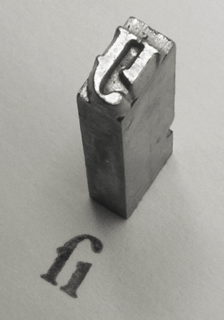 W
WModern typographers view typography as a craft with a very long history tracing its origins back to the first punches and dies used to make seals and coinage currency in ancient times. The basic elements of typography are at least as old as civilization and the earliest writing systems—a series of key developments that were eventually drawn together into one systematic craft. While woodblock printing and movable type had precedents in East Asia, typography in the Western world developed after the invention of the printing press by Johannes Gutenberg in the mid-15th century. The initial spread of printing throughout Germany and Italy led to the enduring legacy and continued use of blackletter, Roman and italic types.
 W
WWoodblock printing or block printing is a technique for printing text, images or patterns used widely throughout East Asia and originating in China in antiquity as a method of printing on textiles and later paper. As a method of printing on cloth, the earliest surviving examples from China date to before 220 AD. Woodblock printing existed in Tang China by the 7th century AD and remained the most common East Asian method of printing books and other texts, as well as images, until the 19th century. Ukiyo-e is the best-known type of Japanese woodblock art print. Most European uses of the technique for printing images on paper are covered by the art term woodcut, except for the block-books produced mainly in the 15th century.